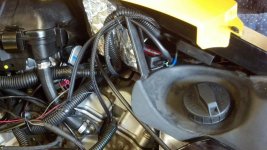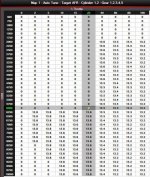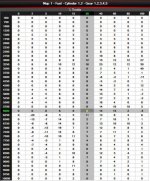I let others deal with the wiring and welding... I just make a mess when I do that.
But I've got the software setup down.
Turn the key to get power but don't start it.
Make sure your throttle reads 0 when it's closed and 100 when it's wide open. This might require cable adjustments and/or a BUDS TPS reset (dealer).
Under Options, Environment I would select Show auto tune tables even if pc is not enabled (helps when you're looking at maps with the bike off) I could create backup maps on connect and on sending map to device.
Turn on Cell tracer, 0.25sec.
Make sure you enable auto-tune
You have 3 main things to look at.
Under Map position 1, Primary Module, Autotune you will see Target AFR and Trim.
Target AFR is the autotune target air fuel ratio. This is what the autotune is going to try and achieve for a given rpm/throttle position pair.
Trim is what that autotune has learned since you last reset the trim tables. It is showing how much fuel to add or remove from the fuel map.
Below that you will see Fuel. This is the actual fuel map the power commander is using. It shows how much fuel is being added or removed from what the stock ECU is recommending.
The Target AFR chart should be completely blank in the area below 40% throttle and below 6000 rpms. This is the closed loop area and the autotune has no control over this area. When you load a map from dynojet this will already be blank. Everything else will probably say 13.2. I don't think dynojet tuned ANY of their downloadable target afr maps at all. But they're "safe" (rich is safer than lean.)
View attachment 50178
The Fuel map DOES effect closed loop but the numbers won't ever be changed by auto tune trims. The maps from dynojet fill the closed loop area with all 5's, 8's or 10's depending on exhaust and intake combinations. They don't really make any sense (the put 10's for stock intake and exhaust, and 5's for the Ron wood race exhaust and open intake?) Lower numbers = leaner = less fuel = higher mileage. Too lean and you'll produce more heat until something gives out, or premature detonations from over heating damage the engine.
View attachment 50179
You'll notice I don't have all 8's in the closed loop area. There are 3 areas I deviate from the dynojet maps.
At low rpms I find a little extra fuel helps smooth things out but that isn't a power generating area so there's no point in overdoing it.
At higher rpms and low throttle position is your cruising area. A little leaner here will increase fuel economy. I get about 30mpg highway and frequently better mileage than my wife (27mpg) when we ride together. Her GS has (had?) the same exhaust and intake but no power commander.
Then there's that funny spot around 3250 rpms. This extra fuel I added manually has completely eliminated a hiccup I had in that area. You'll notice that above 20% throttle the autotune agrees with me and has continued the trend to add more fuel at this rpm. Every motor has it's quirky spots.
BTW, I want to point out that I'm not recommending anyone use any of the values in those images. Just using them as an educational prop. Every Spyder is it's own, every setup unique, every environment different, and every riding style personalized.
Back to the Trim table for a moment. (no screen shot, it's all 0's)
The way this all works together...
At a given rpm and throttle position the stock ECU has a fuel value that it uses to calculate the time to open the injectors. The longer they're open the more fuel. For completeness sake this is called the injector pulse width. Also for the sake of education, there are other values used to calculate fuel such as intake air temp (you have checked that your ambient air temp sensor is installed/relocated haven't you?) and the amount of air flowing into the intake (mass air flow or MAF sensor) and so on (gear selector?)
If closed loop the ECU then checks the stock O2 sensor. The stock O2 sensor on a Spyder is not very sensitive. Most of the time it flips between 2 or 3 values at best which doesn't give an accurate read of uncombusted air flowing past it. But the ECU then uses this "low/ok/high" value to further adjust the fuel for the next cycle (milliseconds later.) To help prevent inconsistencies so pc/at can do their job. Dynojet's O2 Optimizer is installed inline with the stock O2 sensor and pretty much fakes the signal from it to say "GIVE ME ALL THE FUEL YOU CAN!" which in this case is 10% more which is the limit the ECU can provide. (trivia: The Hindle performance exhaust claims 4HP or approx 5% more power which should be within the +/- 10% range the stock ECU is capable of. That's where the claims of "you don't need a fuel computer if you just have a Hindle" come from. However the stock O2 is practically useless so it rarely makes significant adjustments one way or the other.)
The power commander then looks up the rpms and throttle position and modify the amount of fuel that the ECU has requested by adding the amount on the Fuel Map. Done with that.
In closed loop the Auto Tune module goes to sleep. That's right, it does nothing.
Hopefully this comes out to the amount that gives what you want (power, economy, smoothness etc). You can tweak this by manually adjusting the fuel map in the closed loop area (as I described above.)
In open loop the stock O2 sensor is not read by the ECU and the Auto Tune wakes up and checks the newly installed high resolution O2 sensor and make a precise adjustment to the amount of fuel requested in an attempt to achieve the Target AFR from the chart.
It takes this calculated difference and stores it in the Trim table.
You need to apply this Trim table periodically which will add the Trim value to the current Fuel Map permanently. If you don't apply it you won't be getting the full benefit of having the Auto Tune. From experience it takes at least one "bad" run through an rpm/throttle intersection before it "learns". The next time through that rpm range the Auto Tune has learned and it will be able to achieve the Target AF. But the first time it'll stumble through it at the stock value. Apply your trim every time you stop for the first few weeks after installing or after any significant changes (new mods, change in climate, altitude, solar flares...)
What numbers should you use? I dunno. Dynojet ships Target AFR's of all 13.2's across open loop. That's purely to cover their ass. More fuel doesn't always mean more power.
14.65 is supposed to be the best AFR for "perfect combustion". To mean that means both high efficiency and low emissions. Stock my Spyder runs between 14 and 15 (with occasional random jumps to 17 or 21 just to be irritating and backfire a bunch). Since adding the power commander it runs fairly close to the numbers I put in the Target AFR table. I find targeting over 14 doesn't work so well. Just doesn't feel right. 13.6-13.8 feels better. Many people run 13.2 everywhere like Dynojet's base maps and are happy. I think it's personal taste.
There's a lot that goes into finding the right numbers. Like checking plugs between runs etc. But I'll leave that for another lengthy post.






